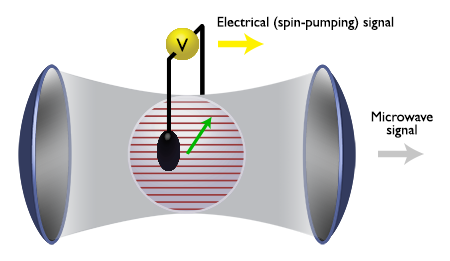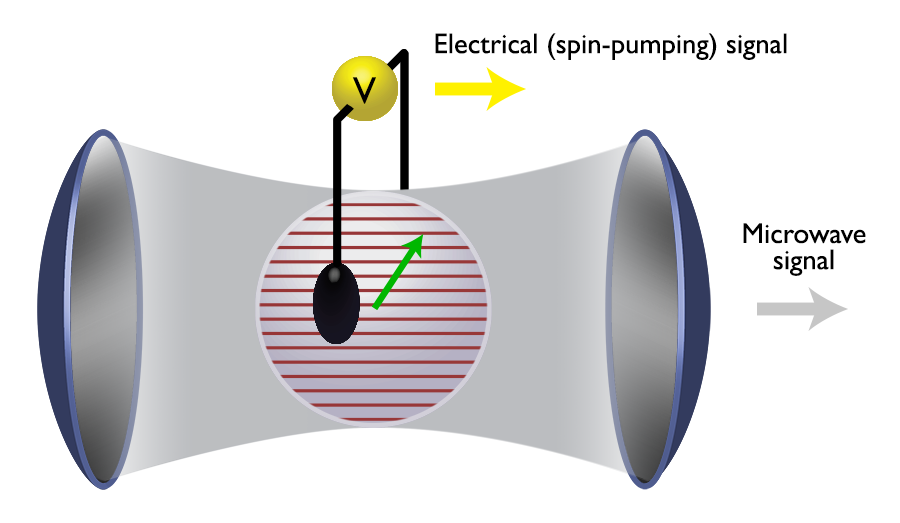Electrical Signal Picks Up a Magnet’s Heartbeat
A strong interaction between light and a magnet can produce a hybrid system with energy levels distinct from either the light or the magnet on its own. In this “strong coupling” regime, quantum information can be easily transferred from the light to the magnet and vice versa. This feature could be useful in quantum information technologies or as a way to use one component (say, the light) to probe the other. So far, most experiments have explored strong coupling via its effects on the light. Can-Ming Hu at the University of Manitoba, Canada, and his colleagues instead detect strong coupling directly from a magnet, which in their experiments is embedded in a microwave cavity [1]. The detection occurs via an electrical signal, suggesting their device could lead to new ways of reading out the quantum state of a magnet with compact electronics.
Magnetism is a quantum phenomenon. But most magnets can be described with classical physics because they consist of large numbers of spins. For example, the coupling between a magnet and an electromagnetic wave can, in many cases, be completely described by Maxwell’s equations. The quantum nature of a magnet can, however, be revealed if it is very strongly coupled to a light field, such as that in a cavity. The starting point is to prepare the electromagnetic field in the cavity in a quantum state, such that the number of photons in the field is a good quantum number. “Switching on” strong coupling between the cavity and the magnet involves aligning a resonance frequency of the magnet with that of the cavity. Under these conditions, energy in the cavity—and quantum information—can be transferred to the magnet. When the coupling is switched off, the quantum information is “stored” in the magnet. Switching on strong coupling again transfers the state back into the microwave cavity, where it can be read out with microwaves [2]. The key requirement of this protocol is that the transfer of energy be faster than the decay mechanisms in either the microwave resonator or the magnet.
Hu and colleagues pursue this approach, but instead of reading out the state of the magnet indirectly with microwaves, they collect a direct electrical signal from the magnet. This signal is generated by the so-called spin pumping effect, which occurs at the interface between a magnet and a metal [3]. The magnet in their experiments is a thin rectangle of yttrium-iron-garnet, topped with a 10-nanometer-thick layer of platinum. When the magnet is excited by the cavity, it relaxes towards equilibrium by transferring a spin-polarized current into the adjacent metal layer. This spin current is accompanied by a transverse charge current (a result of the inverse spin Hall effect) and this spin pumping signal can be detected with conventional electronics [4].
The researchers chose yttrium-iron-garnet because it is an electrically insulating ferrimagnet with a magnetic resonance frequency that lies in the gigahertz range and is therefore excitable with microwaves. (The oscillating magnetic field of the microwaves exerts a torque on the ordered spins in the magnet, exciting their precession.) The experiment consists of inserting the magnet structure into an aluminum microwave cavity and using an external (static) magnetic field to tune the magnet’s resonant frequency to that of the cavity. As they do this tuning, they measure the spectrum of microwaves from the cavity and the spectrum of the electrical spin pumping signal from the magnet (Fig. 1).
What they find is that both the electrical signal and the cavity have sharp resonances when the magnet and the cavity are uncoupled. But when the two components are strongly coupled, these resonances broaden and split in two, a phenomenon known as an “avoided level crossing” that occurs when two systems with identical energies interact. Unlike the peaks in the microwave spectrum, however, the peaks in the electrical spectrum become asymmetric in the strong-coupling regime. This difference is expected, since the spin pumping is sensitive only to magnetic excitations and therefore gives information on the strong-coupling regime solely from the viewpoint of the magnetic system. In simple terms, the spin-pumping signal measures the degree to which the magnet is excited in the strong-coupling regime.
Strong coupling has been demonstrated in a number of solid-state-based hybrid quantum systems, including superconducting circuits [5], spin ensembles in cavities [6] and nanoelectromechanical setups [7], as well as magnets [8–10]. At present, the experiment from Hu and colleagues [1] probes strong-coupling physics in the classical regime. But their experiments demonstrate that it is possible to read out—electrically—information about a magnet strongly coupled to light, and this new technique could lead to a way of investigating magnetic systems on the quantum level. In the long run, their approach could allow for quantum-state detectors that can be integrated into electrical devices.
This research is published in Physical Review Letters.
References
- Lihui Bai, M. Harder, Y. P. Chen, X. Fan, J. Q. Xiao, and C.-M. Hu, “Spin Pumping in Electrodynamically Coupled Magnon-Photon Systems,” Phys. Rev. Lett. 114, 227201 (2015)
- This approach is derived from methods initially established for superconducting quantum circuits, e.g., M. Hofheinz et al., “Synthesizing Arbitrary Quantum States in a Superconducting Resonator,” Nature 459, 546 (2009); Y Kubo et al., “Hybrid Quantum Circuit with a Superconducting Qubit Coupled to a Spin Ensemble,” Phys. Rev. Lett. 107, 220501 (2011)
- Y. Tserkovnyak, A. Brataas, and G. Bauer, “Enhanced Gilbert Damping in Thin Ferromagnetic Films,” Phys. Rev. Lett. 88, 117601 (2002)
- O. Mosendz, J. E. Pearson, F. Y. Fradin, G. E. W. Bauer, S. D. Bader, and A. Hoffmann, “Quantifying Spin Hall Angles from Spin Pumping: Experiments and Theory,” Phys. Rev. Lett. 104, 046601 (2010); Y. Kajiwara et al., “Transmission of Electrical Signals by Spin-Wave Interconversion in a Magnetic Insulator,” Nature 464, 262 (2010)
- A. Wallraff, D. I. Schuster, A. Blais, L. Frunzio, R.- S. Huang, J. Majer, S. Kumar, S. M. Girvin, and R. J. Schoelkopf, “Strong Coupling of a Single Photon to a Superconducting Qubit Using Circuit Quantum Electrodynamics,” Nature 431, 162 (2004)
- Y. Kubo et al., “Strong Coupling of a Spin Ensemble to a Superconducting Resonator,” Phys. Rev. Lett. 105, 140502 (2010); D. I. Schuster et al., “High-Cooperativity Coupling of Electron-Spin Ensembles to Superconducting Cavities,” 105, 140501 (2010)
- J. D. Teufel, D. Li, M. S. Allman, K. Cicak, A. J. Sirois, J. D. Whittaker, and R. W. Simmonds, “Circuit Cavity Electromechanics in the Strong-Coupling Regime,” Nature 471, 204 (2011)
- H. Huebl, C. W. Zollitsch, J. Lotze, F. Hocke, M. Greifenstein, A. Marx, R. Gross, and S. T. B. Goennenwein, “High Cooperativity in Coupled Microwave Resonator Ferrimagnetic Insulator Hybrids,” Phys. Rev. Lett 111, 127003 (2013)
- X. Zhang, C.-L. Zou, L. Jiang, and H. X. Tang, “Strongly Coupled Magnons and Cavity Microwave Photons,” Phys. Rev. Lett. 113, 156401 (2014)
- Y. Tabuchi, S. Ishino, T. Ishikawa, R. Yamazaki, K. Usami, and Y. Nakamura, “Hybridizing Ferromagnetic Magnons and Microwave Photons in the Quantum Limit,” Phys. Rev. Lett. 113, 083603 (2014)





